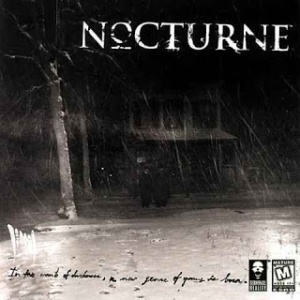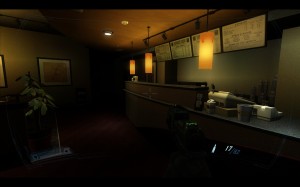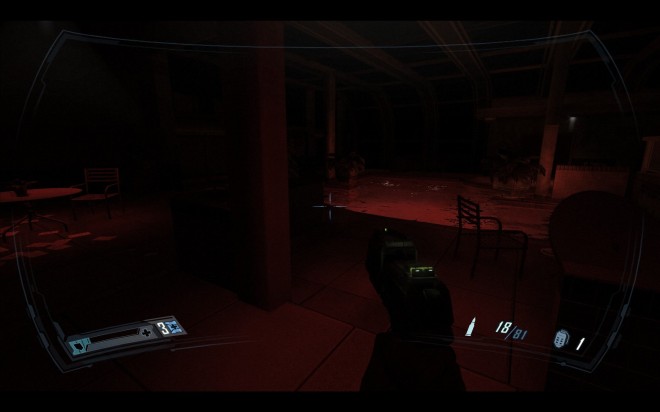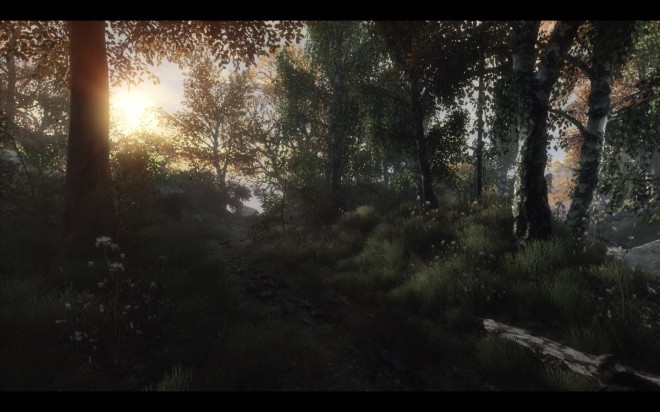[Readers note: This was initially drafted in 2020 – that year of years – when fires in California were made evident in the atmosphere across the United States. While temped to update it for a 2023 reading, better wisdom said it should stay as is, as a sort of time capsule. Though, hopefully, you’ll find the themes more timeless. Thanks for the 10 or so minutes to read it. I appreciate you]
I began writing this three years ago. [lol, *ahem* – ed.]
Mirror’s Edge Catalyst – the maligned sequel to that darling of an older generation – was at the time only a year old. Its technology still fresh, before the promise of Unreal’s nanite and that holy grail of real-time rendering: raytracing. The game still astonishes with its beauty. But the shadow of that relentless tide of “progress” looms.
But my point is not to wax on technology that I can only embarrass myself trying to explain. Instead I want to talk about a sense – a feeling – that I often got playing the game, back in 2017, which was a different time than thinking back on it from the smoky horizon of late 2020.
Like the game’s tech, Catalyst’s themes are both relevant and slightly aged. Playing a game about a soft-dystopian corporatocracy, where the lines between social policy and a consumer market are blurred to indistinction, where laws reflect the demands of the powerful as much as, well, anything else feels different today than it did even three years ago.
It’s pointless to rehearse the current climate if you’re reading at the time of post. But for the sake of retrospect it may be more valuable. Outside my home, the sun filters through a screen of smoke birthed 2000 miles away, where fires burn on a scale that has outgrown us. Recent pictures of the Golden Gate bridge look like they were taken from the latest Blade Runner. In Kansas, where distance from the coast (geographically and ideologically) is often worn as a badge of honor, our air-quality index mirrors that of a coastal city. Natural disaster, how much of which we are debating was due to our industrial habits, has again revealed the deep existential connection we share, despite our attempts to separate from one another. The smoke in our upper atmosphere, however, is beautiful, diffusing the sunlight into a soft bloom that makes the whole day look like dawn, or dusk. Its beauty masks the poison it carries.
I needn’t belabor the current presidential election, the stakes said to be the fate of democracy itself, performed under a safety net of social media and facial masks that protect us from a global virus that targets the frail and the marginal. The social response to the virus at times reflects this pathogenic selectivity; we’ve seen the marriage of biology and politics with stark clarity. The campaign(s), regardless of its outcome, will become legend, historical fodder for decades. Our children suffer the fragility of our grasping with these realities and the waffling of our equally fragile judgments.
One of mine drew a cat on her mask.
Meanwhile, a city I once frequented for its relative calm smolders after a string of riots that began with an unarmed black American being shot seven times in the back at the hands of police, the latest in a string of such cases. Here, a 17 year-old walked into a crowd of protesters, shot and killed two of them (neither armed), and walked – past security – back home to sleep. This incident was immediately politicized, and arguments for “murder” and “self-defense” drawn explicitly down party lines. To some, his actions were patriotic, defending as he was the right to private property. The year has seen a level of racial tension not seen since 1965.
And for my theological readers, the ‘faithful’ in North America, far from being the vanguard on these issues, has mostly assumed those predetermined lines and their respective narratives about the climate, justice, or racism full stop. Christians are simply as divided as everyone else, and for the same reasons, but now granting those positions ‘divine’ sanction. It’s been a strange, awful, illuminating year.
So if time and space affects how a game is read, so to speak, my initial impressions on playing Catalyst now seem quaint. And yet, I can’t get the game, its vistas, its immaculate score, its euphoric sense of motion, and its atmospheric unease out of my mind. Who knows, maybe it has more to say today than at launch.
Mirror’s Edge was seen as a mixed bag in 2008. It was beautiful, occasionally breathtaking but flawed. Being about parkour, it was inevitably judged alongside the meteoric impact of Assassin’s Creed. In comparison, it was ambitious, but clunky – I remember vignettes comparing the mechanics for doing wall-jumps between the two games. Mirror’s Edge and its steep requirement of complex, well-timed button combinations paled, it was argued, in light of the elegant simplicity of Creed’s spacebar. This was the era of Creed, Arkham, and the contextual brawler. Games that counted on directional timing and clever animation to simulate dexterity. And it was euphoric. Watching the cinematic fight choreography of Batman unfold was a revelation.
Time may be kinder to Mirror’s Edge, however. The spectacle of that generation gave way to the creative promise of more complex systems. I personally have had a hard time going back to the Arkham games after mastering the combat of Dishonored 2 – the latter having a larger curve for mastery, sure, but one that allows for systemic poetry. So too with Mirror’s Edge. The free running is harder than the two-button system of Creed, but as the still-vibrant community of runners on Catalyst shows, mastery is a matter of degree, and the higher the degree, the more exhilarating one’s experience. Mirror’s Edge the First was a generation too early. We just weren’t ready for it.
By 2016 we were, however, and the high-profile sequel had to contend with the cult status of its predecessor. The promise of an open-world Mirror’s Edge was tantalizing, and probably doomed in principle. Just imagine the design nightmare such a pitch would be, not to mention the visual spectacle that would make good on its trademark. Catalyst was a massive and risky undertaking.

The rest is history: a great concept marred by jarring design interruptions, an unoptimized use of a demanding engine, a predictable story and an unrelatable protagonist. Sales equating to “meh” and its subsequently canceled DLCs. And one of the most beautiful playgrounds ever created in the history of gaming.
Of all of its many negative critiques, and there are many, none despise the sheer, awe-inspiring visual art of its world. And this, I think, held for me one of the game’s more profound elements. As Guillermo Del Toro is often cited saying, strive not for eye-candy, but “eye protein”. A visual panache that adds something of substance to character, story, or themes. And I think that Catalyst is packed with it.
Thematically speaking, Catalyst is, like its predecessor, of cyberpunk orthodoxy: taking place in a neo-capitalist dystopia, where corporations tower over its subjects. To reject the deluge of advertisement and materiality is to mark oneself suspect to the state, itself subject to the whims of the hyper-wealthy. Cameras constantly check your presence for nonconformity and record your movements for the mediators of this social arrangement: the police. This ordering is reflected in the impossible towers of the largest corporations – weapon developers, security firms, technology corporations – titans watching over an urban landscape. The largest and most awe-inducing of these is, as in the first, the “Shard” – its spire puncturing the clouds and housing a wind-turbine that surpasses in scale the massive fans peppering the American Midwest. It is always seen, or rather watching, like a futuristic Barad-dûr.
So: economic disproportion resulting in the abject poverty of many, whitewashed as one climbs the economic and physical space; the state’s subjugation to the megacorporation; omnipresent surveillance and a police state serving as the point of contact – the buffer – between a fragile and violent will-to-power and the masses over which it exercises this will, masquerading as existing “for the common good.” Propaganda rings out like sirens at intervals throughout a day, like a call to prayer from the state’s minarets.
The tension present in these sirens, the police and its systems, and in the glib classism occasionally heard in muffled tones through the pristine glass panes of the elite all bring to mind an anxiety described by Fanon as the product of an uneasy arrangement of subjugation; the powerful know that their situation is built on a false and precarious myth about different grades of humanity. That when the poorest realize that the bill of goods they are sold as representative of this humanity, something to strive for, is shown false, a veneer, then there is nothing stopping the masses from shattering that fragile system in revolution.
The measure of surveillance and thought control is directly proportional to the degree of social disproportionality, the gap between the well-off and the unseen, and the anxieties of the powerful at recognizing this arrangement as the glass floor it is.
It’s an evocative image.
And truthfully, I’m not sure if all of this was the intent of the minds of the developers at DICE. But, I’m not sure it really matters. It is the fate, so to speak, of art and literature to transgress the original intent of its author. It is what makes such art timeless.
But let’s do a thought experiment.
Say you’ve never seen the game or know anything about the series. You’ve never watched a let’s play, a vlog, or even looked at any screenshots (including those I’ve posted here). What is the image that comes to mind? What does this look like? For some, those familiar with the genre conventions, it likely looks something like Blade Runner – rainy streets decorated by rotting trash, neon lights, spectacular penthouses juxtaposed with squalid apartments carved out of whatever space is available. Red light districts and advertisements for a thousand venues of temporary escape from this social purgatory, if one has the money of course.
Or.
Or, maybe what I described feels altogether prescient. Eerily so. A cracking veneer of social norms defined by the most wealthy, the omnipresence of screens and advertisements, the impossible global reach of the largest corporations, and echoes of a police state, or at least the threat of one, and a chasm of economic disparity widening to the point of implosion. The anxiety of a glass floor. For some, maybe less familiar with genre conventions, my description of The City in Catalyst sounds too familiar for comfort.
My point is not to say that we’re there. That we’ve reached the heights of despotic corporatocracy shown in the game. But, the world of Catalyst is worth reflecting on.
The thing that distinguishes Catalyst from other cyberpunk stories is, well, first, its cleanliness. The majority of the game takes places on the city’s rooftops which is like a city on top of a city. Your playground is the domain of the rich, the politicians, the CEOs, and the tastemakers. It’s usually daytime, the air seems clear, and the sunsets are Zen-inducing. Nighttime is equally gorgeous. This is more Aldous Huxley than Blade Runner: dystopia under the shell of perfection. Occasionally you work your way down, to the homes of the resistance, which (not subtly) is in an old sewer system. But even here, while dirtier, darker, and grimier even the abandoned sewers of the City are cleaner than the streets in Blade Runner. The City, aesthetically anyway, seems like a very nice place to live.
The other thing about this quality is how familiar it all feels. It is beautiful and artful, and fantastical, but also normal. One finds no cyborgs or biomechanical transhumanism (sorry Deus Ex, I still love you!) Construction sites harbor the same edifices of steel, concrete, and industry we are all familiar with. The interior of business offices look like business offices. All the cars are firmly grounded, and presumably driven by people thank you very much, and the marketing sounds exactly like it does on our iPhones. The futuristic “gridlink” – Catalyst’s social networking device – seems like a plausible evolution of our smartphones. It’s also the state’s first line of surveillance. Considering cases like the Prism leak, the game feels again, prescient.
It’s in between that one gets the sense that something’s up: a water shortage is pressing, while the Shard houses an enormous terrarium with an indoor waterfall. The Greylands, where criminals are exiled and most of the lower caste spend their lives in service to the conglomerates, where cancer is ten times more frequent and fresh water scarce. It’s use in the city is mythical, as a threat for nonconformists.
A good citizen in this world is called an “employ”.
So here’s the point. When I was playing this in 2017, there was a place in the City of Glass I would often visit to get away from my own real-world of responsibilities for a bit. The first time I stepped out of the narrow corridor into this place was one of the few, if not only time, in a game that I was dumbstruck. I remember even gasping softly at the sheer artistry I was seeing in a videogame. It remains a bar-setter in my mind for beautiful game art. This district was aptly titled, “The View”. It was fresh water and boats and sunlit lounges, it was blue glass and softened angles, cherry blossoms and surgically placed spotlights, highlighting all of these artifacts of affluence on the eve of unlimited power. It was distinctively artful in a game absolutely filled with artful vistas.
But here is also where it hit me. When I was here, playing, I often made a conscious point to forget that which funded such a space within the game’s world. I let the story, the themes, slip away and allowed myself for those 10 or 15 minutes to just slip into this beautiful space without any visible indication of industry or responsibility or, as it was, the asymmetry that created it. It was like taking soma in Huxley’s Brave New World. Forget the bad, the unjust on which I profit. You deserve it.
It was beauty, masking the poison. Like the smoke in our atmosphere.
It occurs to me that this moment, this space, in the second Mirror’s Edge is maybe its most profound for us. It asks us what we are willing to pay for comfort. In the City of Glass, the majority of employs are middle class, working for the 13 conglomerates that run things, in the promise of achieving that which your character – Faith – tramples over in subversion. A few in this world of the elite – the norm for the rest – recognize the veneer and are willing to disrupt it even at their own expense. Humanity still exists, even here. But for the vast majority, they are sold a narrative, one that tells them to buy and consume, and not ask too many questions about the process, for that is what life is about. It directs the gaze away from the glass cracking underneath, to the elysian vistas of yachts and cherry blossoms.
Eventually, as I played this, I realized that to stay in the Ocean Glass View would be irresponsible. Eventually, we need to go elsewhere.






















 First, I have a hard time role-playing a character too far from my own convictions. To play as a raging nihilist is just too uncomfortable. But for me, Dishonored tested my convictions, hard. I always felt uneasy with going after a mark on the word of some guys, but things got grey when you set your boots to the cobbles. The deeper you traveled in each district, the more you uncovered dirt on the targets, and the more you felt justified in hating them. These characters walk comfortably in an absolute moral vacuum – truly, horrible people. Furthermore, when a target is “eliminated” the game gives you a slick, so-mo animation.
First, I have a hard time role-playing a character too far from my own convictions. To play as a raging nihilist is just too uncomfortable. But for me, Dishonored tested my convictions, hard. I always felt uneasy with going after a mark on the word of some guys, but things got grey when you set your boots to the cobbles. The deeper you traveled in each district, the more you uncovered dirt on the targets, and the more you felt justified in hating them. These characters walk comfortably in an absolute moral vacuum – truly, horrible people. Furthermore, when a target is “eliminated” the game gives you a slick, so-mo animation.